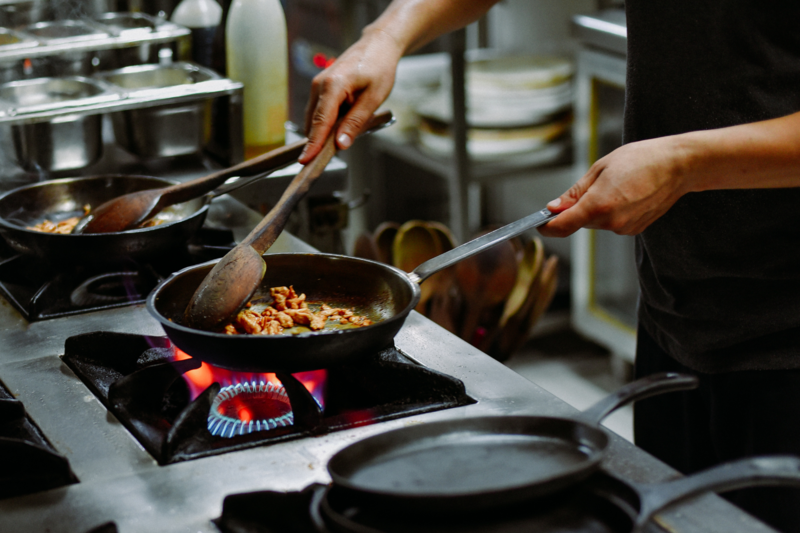The term “ghost kitchen” became popular during the explosion of food delivery in 2020, although its origins date further back. Over the years, the function of ghost kitchens (also known as dark kitchens) has evolved to support different foodservice business models.
Ghost kitchens can take many forms. A definition that includes them all is a commercial kitchen without storefront, street sign or dining space, that prepares food that is delivered (and consumed) elsewhere.
Ghost kitchens and virtual restaurants
The most popular model of ghost kitchens is the one behind a virtual restaurant, a delivery-only operation that can be found exclusively on apps such as Uber Eats or Glovo.
This concept comes in various forms. Many virtual restaurants operate as independent establishments run from ghost kitchens. However, in the past few years, several brick-and-mortar chains in the U.S. launched their own virtual brands, using their existing kitchens instead of ghost kitchens. While some of these ventures, like Burger Den (operated by diner-style chain Denny’s) remain successful, others, such as Applebee’s Cosmic Wings, were short-lived.
Virtual restaurants can also be part of a portfolio of concepts developed and managed by specialized companies. For example, Finland-based Munchfarm, UK-based Peckwater Brands or Virtual Dining Concepts in the U.S. operate multiple brands, each centred around specific foods like pizza, burgers, or kebabs. Some of these brands gain extra visibility through celebrity endorsements or co-branding, such as Mariah Carey’s Cookies or Packed Bowls by rapper Wiz Khalifa.
The host kitchen model
To optimize resources, many virtual restaurant companies have started to use host kitchens instead of dark kitchens. Host kitchens are a hybrid model where the virtual brand partners with a brick-and-mortar restaurant to use part of its resources to prepare food for delivery. All the restaurant staff needs to do is follow the recipe using the provided ingredients, while the virtual brand operator takes care of everything else.
This model has advantages for both restaurants, which can make additional income from underutilized kitchens, and virtual brands, which can operate without having to own or rent a ghost kitchen. It’s also a more sustainable option because it uses existing resources rather than adding new ones.

Pros and cons of virtual restaurants
Virtual restaurants have advantages but also specific challenges, compared to brick-and-mortar operations.
Advantages:
- Lower costs. Without the need for a dining room and storefront, or reliance on foot traffic, virtual restaurants can operate in smaller spaces and less expensive locations. Labour costs are also lower, as they need back-of-house staff only.
- Data-driven decisions. Since all their activity is online, virtual restaurants allow operators to collect extensive data to optimize costs, experiment with new brands, and quickly identify what works and what doesn’t.
Main challenges:
- High third-party app fees. Virtual restaurants depend entirely on third-party delivery apps, which often charge high fees. This can be particularly challenging for small independent operations with lower bargaining power.
- High competition. The food delivery market is crowded, with competition from both other virtual brands and traditional restaurants. Additionally, delivery menus are often constrained to dishes that travel well, which limits the opportunities for differentiation compared to traditional restaurants. As a result, virtual brands must focus heavily on optimizing costs and developing their identity to stand out.
- Maintaining quality standards. Ensuring consistent quality can be difficult, particularly for virtual brands using a host kitchen model. Standardized and detailed preparation instructions and strict quality control are essential to maintaining customer satisfaction.
Other types of ghost kitchens
A less frequently discussed type of ghost kitchen is the commissary kitchen, which serves various purposes:
- Supporting other restaurants. These kitchens can be part of the operations for a restaurant or hotel chain with multiple locations in the area. They handle tasks like ingredient preparation or cooking elaborate dishes, reducing the workload of individual kitchens and improving efficiency. A commissary kitchen can also be an independent entity that offers cooking and prepping services to other restaurants.
- Supplying other ghost kitchens. In a hub-and-spoke model, commissary kitchens prepare food that is distributed to smaller, local ghost kitchens, which then complete preparation and manage delivery.
- Providing for food trucks. Commissary kitchens offer additional space for food trucks to store and prep ingredients. In some U.S. states, food trucks are not allowed to prepare food for public sale unless they use a certified commercial kitchen, making commissary kitchens a necessity.
The future of dark kitchens
After the explosive growth of food delivery in 2020 and 2021, the industry slowed down its expansion but is still expected to keep growing in the coming years. Major delivery platforms such as DoorDash and Deliveroo have achieved profitability, while others like Delivery Hero are expected to reach it soon.
On the other hand, many analysts believe that the role of dark kitchens, particularly those tied to a virtual restaurant, may have been overestimated. As traditional chains move away from virtual spin-offs and virtual restaurant operators seem to favour the host kitchen model, their original function is being reassessed.
Early ghost kitchen companies such as Cloud Kitchens and Kitchen United struggled to establish sustainable models, while new ventures like Chef Suite and Nimbus Kitchen are repurposing the concept of ghost kitchens as spaces available for long-term or hourly rentals, supporting the needs of restaurants, catering companies, and other food businesses.
AUTORE
















